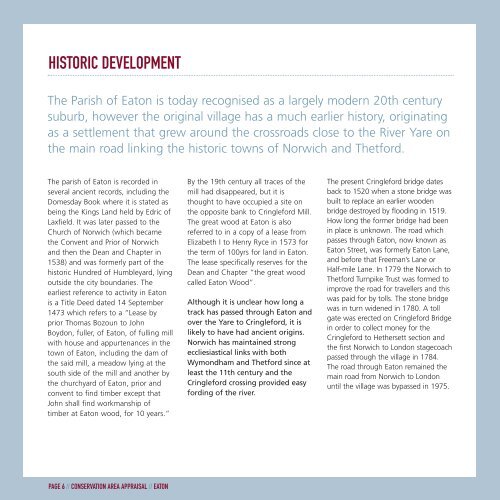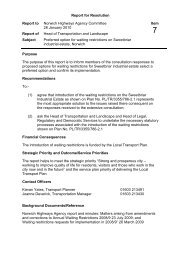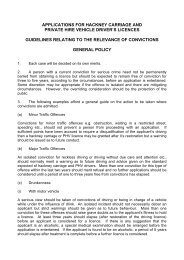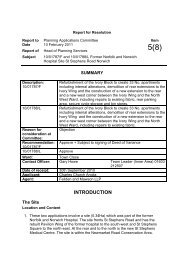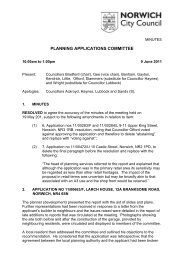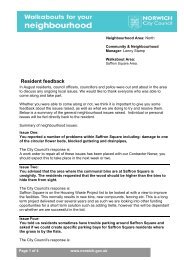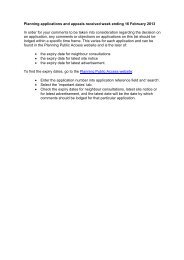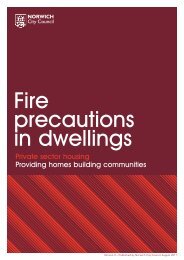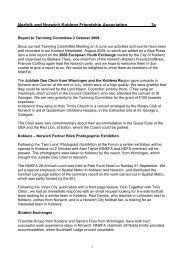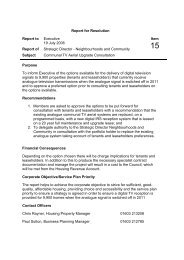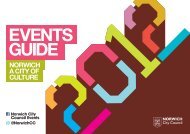eaton conservation area appraisal - Norwich City Council
eaton conservation area appraisal - Norwich City Council
eaton conservation area appraisal - Norwich City Council
Create successful ePaper yourself
Turn your PDF publications into a flip-book with our unique Google optimized e-Paper software.
HISTORIC DEVELOPMENT<br />
The Parish of Eaton is today recognised as a largely modern 20th century<br />
suburb, however the original village has a much earlier history, originating<br />
as a settlement that grew around the crossroads close to the River Yare on<br />
the main road linking the historic towns of <strong>Norwich</strong> and Thetford.<br />
The parish of Eaton is recorded in<br />
several ancient records, including the<br />
Domesday Book where it is stated as<br />
being the Kings Land held by Edric of<br />
Laxfield. It was later passed to the<br />
Church of <strong>Norwich</strong> (which became<br />
the Convent and Prior of <strong>Norwich</strong><br />
and then the Dean and Chapter in<br />
1538) and was formerly part of the<br />
historic Hundred of Humbleyard, lying<br />
outside the city boundaries. The<br />
earliest reference to activity in Eaton<br />
is a Title Deed dated 14 September<br />
1473 which refers to a “Lease by<br />
prior Thomas Bozoun to John<br />
Boydon, fuller, of Eaton, of fulling mill<br />
with house and appurtenances in the<br />
town of Eaton, including the dam of<br />
the said mill, a meadow lying at the<br />
south side of the mill and another by<br />
the churchyard of Eaton, prior and<br />
convent to find timber except that<br />
John shall find workmanship of<br />
timber at Eaton wood, for 10 years.”<br />
PAGE 6 // CONSERVATION AREA APPRAISAL // EATON<br />
By the 19th century all traces of the<br />
mill had disappeared, but it is<br />
thought to have occupied a site on<br />
the opposite bank to Cringleford Mill.<br />
The great wood at Eaton is also<br />
referred to in a copy of a lease from<br />
Elizabeth I to Henry Ryce in 1573 for<br />
the term of 100yrs for land in Eaton.<br />
The lease specifically reserves for the<br />
Dean and Chapter “the great wood<br />
called Eaton Wood”.<br />
Although it is unclear how long a<br />
track has passed through Eaton and<br />
over the Yare to Cringleford, it is<br />
likely to have had ancient origins.<br />
<strong>Norwich</strong> has maintained strong<br />
eccliesiastical links with both<br />
Wymondham and Thetford since at<br />
least the 11th century and the<br />
Cringleford crossing provided easy<br />
fording of the river.<br />
The present Cringleford bridge dates<br />
back to 1520 when a stone bridge was<br />
built to replace an earlier wooden<br />
bridge destroyed by flooding in 1519.<br />
How long the former bridge had been<br />
in place is unknown. The road which<br />
passes through Eaton, now known as<br />
Eaton Street, was formerly Eaton Lane,<br />
and before that Freeman’s Lane or<br />
Half-mile Lane. In 1779 the <strong>Norwich</strong> to<br />
Thetford Turnpike Trust was formed to<br />
improve the road for travellers and this<br />
was paid for by tolls. The stone bridge<br />
was in turn widened in 1780. A toll<br />
gate was erected on Cringleford Bridge<br />
in order to collect money for the<br />
Cringleford to Hethersett section and<br />
the first <strong>Norwich</strong> to London stagecoach<br />
passed through the village in 1784.<br />
The road through Eaton remained the<br />
main road from <strong>Norwich</strong> to London<br />
until the village was bypassed in 1975.


